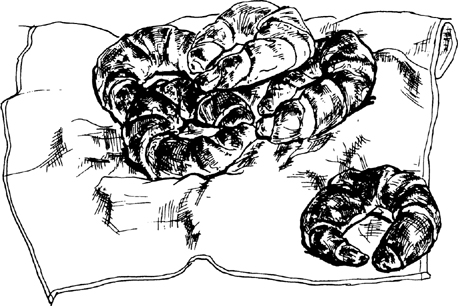Mastering the Art of French Cooking, Volume 2 (44 page)
Read Mastering the Art of French Cooking, Volume 2 Online
Authors: Julia Child

A 6-cup
Kougloff
mold, or any fluted ring mold 3½ to 4 inches deep and about 8½ inches at rim diameter that holds 6 cups
¼ cup shaved blanched almonds (skinless almonds sliced paper thin, available in cans or plastic)
To soften raisins, soak 10 to 15 minutes in very hot water; drain, twist hard in the corner of kitchen towel to squeeze out accumulated water, and spread out on a paper towel until needed. Butter the mold heavily, then sprinkle a tablespoon of the almonds in the bottom, reserving the rest until later.
1)
Softening the dough
If needed, 3 to 4 Tb milk and/or butter
So that it will mold smoothly, dough for
Kougloffs
must be soft and sticky. If you are making the dough specifically for a
Kougloff
, knead in only 4 of the 6 ounces of butter called for in Steps 2 and 4 of the
Master Recipe and complete the recipe through Step 8. After the second rise, knead in the remaining 2 ounces of butter and the raisins. If you are using leftover
brioche
dough, soften it by kneading in milk and/or butter by half tablespoons, then knead in the raisins.
2)
Filling the mold and final rise
A pastry scraper or stiff metal spatula
A rubber spatula
The remaining almonds
A tablespoon or so of flour
Gather a 2-tablespoon gob of the soft dough on the end of your scraper or metal spatula and use the rubber spatula to dislodge it and place it on the bottom of the prepared mold. Continue spreading it around the mold to make a layer. Sprinkle or press more almonds against inside of mold, and add another layer of dough; continue thus until all dough is used. Sprinkle lightly with flour and press dough gently against sides and cone of mold with floured fingers. Mold will be about ½ filled. Let rise uncovered at around 75 degrees for an hour or more, until mold is almost filled.
3)
Baking—oven at 475 degrees, then at 350; 30 to 40 minutes
Bake at 475 degrees in middle or lower-middle level of preheated oven for about 15 minutes, or until dough has risen and started to color. Then lower thermostat to 350 degrees for rest of baking.
Kougloff
is done when it shows a faint line of shrinkage from sides of mold and when the sides are nicely browned. Serve slightly warm or cool, with butter.
The processor can work wonderfully with some doughs. The trick is to process the dry ingredients and butter first, then—with the machine running—to pour in ¾ of the liquid called for. Never stop the machine; add the rest of the liquid by dribbles until the dough masses on top of the blade and rolls around under the cover for 15 to 20 seconds, for the preliminary kneading. If dough is too damp, it will not mass; sprinkle in a little flour, which may help. If not, knead by hand. By experimenting, you will find the way that works best for you. |
|
Freezing brioche dough
The best time to freeze
brioche
dough is after the second rise, but you may also do so after it has been formed and before the final rise. However, and probably because of the high butter and egg content, its life in the freezer is not long: a week to 10 days is all we would suggest.
CROISSANTS
The most delicious of French croissants, to our mind, are those called
croissants de boulanger
, which are made of risen yeast-milk-and-flour dough that is flattened out, slathered with butter, folded in three, and rolled and folded again three times as though you were making French puff pastry. There are other formulas for croissants, including some which are really puff pastry or
brioche
dough rolled into crescent shapes. And in some of the quick methods the yeast dough has only a short single rise, resulting in a semi-puff pastry. None of these, to our mind, produces the tenderly layered, puffy, deliciously buttery croissant one dreams of. The old classic method does just this—and why go to all the trouble of making croissants otherwise?
CROISSANTS
The minimum time required for making croissants is 11 to 12 hours. Included are 3 hours and 1½ hours for the rising of the initial dough, two rest periods of 1½ to 2 hours each, and a final pre-baking rise of about an hour. Therefore, if you want freshly baked croissants for breakfast you will have to stay up all night as the bakers do. However, they will taste just as fresh if you make them ahead and freeze them either fully baked or ready to bake, as indicated in the recipe.
For one dozen 5½-inch rolls
1)
The basic dough




